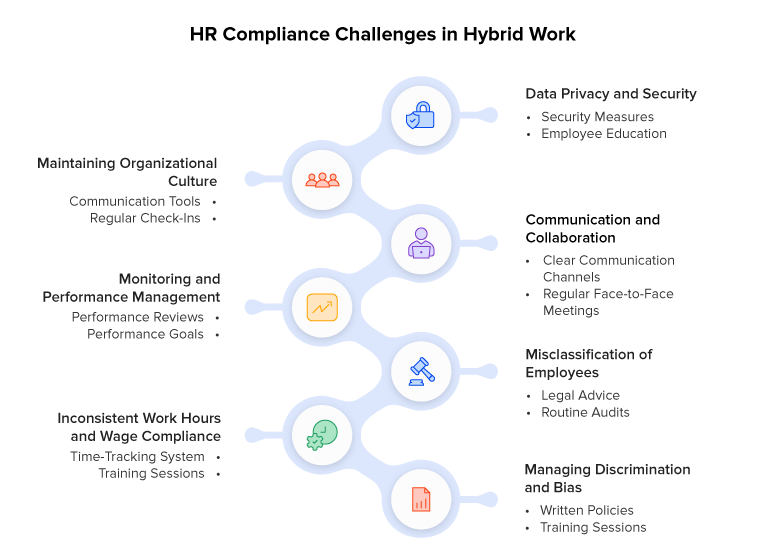HR Compliance Challenges in Remote and Hybrid Work

Table of Contents
After COVID-19, organizations have started implementing hybrid work arrangements. They recognized that employees could sustain productivity regardless of their work location. Hybrid work arrangements mean managing teams that could be in the same city or across borders. This means HR professionals not only have to manage cross-border teams but also have to maintain compliance with international labor laws. Additionally, teams in different cities encounter challenges such as collaboration and communication gaps, which hinder efficient operation.
As a business grows, compliance issues, such as international labor laws for new locations, also increase. Organizations must ensure compliance with both state-specific and occasionally international labor laws. They have to stay legally compliant by following all the rules and regulations. This blog highlights many organizations’ common HR compliance challenges in hybrid work and features solutions for these common issues that can help maintain compliance.
What are the Common HR Compliance Challenges in Hybrid Work?
There are various challenges in a hybrid work arrangement when it comes to HR compliance. These issues lead to confusion between teams and decrease productivity. There are solutions to HR compliance challenges that help with the smooth functioning of the hybrid work model. Some of these challenges are mentioned below.

Communication and Collaboration
Communication and collaboration are some of the most common challenges that an organization faces. These issues happen as some people are available at the office, and some are working from home. This leads to communication gaps across teams as employees feel disconnected from their group, and collaboration is difficult when employees feel out of the loop. Healthy workplace relationships enhance teamwork by minimizing stress levels in the work environment.
Solution: To solve this challenge, choose clear communication channels that include centralized messaging tools and project management software to monitor progress. Arranging regular face-to-face meetings can help employees stay on the same page. Provide training to them on how to use different communication and collaboration tools.
Managers should maintain transparency in communication by sharing regular updates and information with all employees. This way, remote employees can stay in the loop with the latest information and increase operational efficiency.
Monitoring and Performance Management
It is difficult for managers to evaluate employees’ work when they are working remotely or in a hybrid model. One reason for this is a lack of frequent meet-ups, which leads to decreased productivity. Also, managers have less oversight of employees’ work and cannot assess their productivity in real time. Employees’ activities cannot be monitored when they are working remotely.
Solution: Managers should regularly conduct performance reviews and provide feedback to employees. They should also establish performance goals and metrics for employees to achieve, which can be done through a performance management system. This system helps monitor employees’ progress with metrics, like project completion rates and sales figures.
Provide continuous and constructive feedback to help with employees’ career development. Supervisors should know that the results or outcomes are important, rather than the work arrangement in which employees work.
Inconsistent Work Hours and Wage Compliance
HR professionals face difficulties in calculating employee work hours when working remotely. It is also difficult to calculate wages, keeping in mind different locations and states, as they have different wage rates and hour laws. State rules include minimum wage rates and special provisions for other types of employees. Non-compliance with these rules leads to financial penalties and damages the brand reputation.
Solution: Organizations should choose an accurate time-tracking system to record attendance for remote and hybrid work arrangements. Managers need to maintain open communication with employees regarding their recorded work hours. Organizations should provide training sessions to HR professionals to help them stay relevant with wage and hour laws. Organizations stay updated with labor laws and take necessary steps to be relevant with HR compliance. HR professionals can stay updated with compliance-related tasks and their deadlines.
Misclassification of Employees
Employee misclassification occurs when individuals are labeled as independent contractors rather than employees. Legal definitions exist for classifying employees across various locations. If employees are misclassified, it can lead to financial penalties and liabilities for an organization. This situation also damages a company’s reputation and makes it challenging to retain them.
Solution: To solve this HR compliance challenge, organizations should get professional and legal advice on employment laws to ensure that employees are classified accurately. When company policies are based on legal definitions, they help avoid legal or financial penalties. In case of any misclassification, routine audits must be performed to identify errors and implement corrective actions. Managers and supervisors should know the classification criteria and provide training to avoid the consequences of misclassification.
When a remote employee is treated as a contractor but is an actual employee of the firm, it means the employee is denied certain rights, like overtime pay or incentives. Many modern organizations use HR technology to help manage workers’ classification and maintain compliance.
Data Privacy and Security
The hybrid work mode requires employees to have access to various documents and devices to continue their work. Sometimes, company data may be accessed from an unsecured network or device, which increases the risk of data breaches. This can lead to cyberattacks or ransomware attacks to steal data or disrupt a company’s day-to-day operations.
Companies need to comply with various data protection laws, like the General Data Protection Regulation (GDPR). These laws help prevent the misuse of employee data and sensitive information. Nevertheless, ensuring adherence to data protection regulations across various locations can pose challenges for organizations.
Solution: Organizations should choose powerful security measures covering privacy policy and data encryption to solve this challenge. Multi-factor authentication and monitoring tools help secure HR systems for remote employees. Organizations should also educate their employees on activities, such as phishing attempts and cyberattacks, to handle sensitive information. They should focus on security policies as well and implement them regularly to protect company data. Also, performing audits and checking if the security systems are always working is advisable.
Maintaining Organizational Culture
The hybrid work mode has multiple benefits, like flexibility and productivity, but it also has some challenges. The arrangement makes it difficult for employees to feel connected to the organization regarding communication. It can lead to communication gaps that prevent teams from collaborating efficiently, as informal discussions diminish.
Sometimes, in-office employees have more opportunities and exposure than remote employees. This is due to remote employees’ lower visibility, which is a challenge for almost every modern organization. This leads to the risk of burnout and workplace stress.
Solution: Organizations should use various communication tools to keep employees informed and increase employee engagement. HR professionals and managers should schedule regular check-ins so employees feel included in the organization’s culture. The organization’s values should be aligned with HR practices, and employees should be informed about how each project supports the company’s mission. Focus on giving remote and hybrid employees equal opportunities and exposure to motivate them.
Companies should promote a healthy work-life balance and access to various resources, which helps employees understand that their organization values their mental well-being. They should also provide regular feedback to make employees feel valued and engaged.
Managing Discrimination and Bias
Sometimes, employees face distance bias, which leads to unfair performance evaluations. Managers can give low ratings on employees’ performance unconsciously or intentionally, and they might not always receive promotions. Remote employees might be viewed as less valuable and more expendable when faced with discrimination in the organization. Due to this unfair treatment, employee morale and engagement decrease.
Solution: Organizations should focus on creating clear written policies to help avoid any discrimination and bias for remote employees. Training sessions should be arranged for top-level management to avoid unconscious bias. Metrics and standardized evaluations must be used for all employees, including in-office and remote workers. Companies should start this practice from the recruitment stage to help keep the organization’s impression positive and promote workforce diversity.

Conclusion
After COVID-19, businesses observed a shift from the office to remote and hybrid work arrangements. This process includes many challenges organizations must solve before employee turnover increases. Companies and HR professionals must comply with labor laws for multiple locations and cybersecurity. They also must maintain equitable treatment for remote and hybrid employees to help decrease employee turnover.
HR professionals should create policies with strong security measures to solve these HR compliance challenges. The success of a hybrid work arrangement depends on a company’s ability to maintain HR compliance and employee well-being. HR software plays an essential role in solving challenges related to HR compliance with hybrid work arrangements. It helps organizations increase their overall efficiency in HR processes and leads to success.
Grow your business with factoHR today
Focus on the significant decision-making tasks, transfer all your common repetitive HR tasks to factoHR and see the things falling into their place.

© 2025 Copyright factoHR


